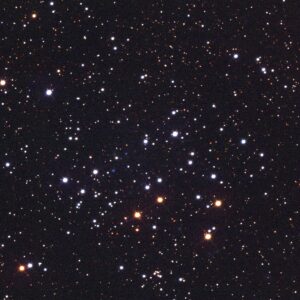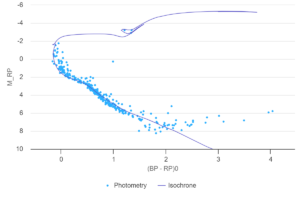NGC 5316 is an open cluster of intermediate age in the southern constellation Centaurus. Discovered by James Dunlop in 1862, it is approximately ~4000 light years away from Earth, in the Carina-Saggitarius arm. The estimated age of NGC 5316 varies quite greatly, the lowest of 51 myr. measured in 1968, while the highest was measured to be 195 myr. in 1991, by Battinelli and Capuzzo-Dolcetta. In the same 1991 study, they found that the neutron capture indicates its birthplace is somewhere enriched with neutron-capture elements.
To study NGC 5316’s relationship between colours, brightnesses, age, and chemical composition, I took five sets of three photos in different filters, B, V, and R with the PROMPT6 telescope. On Skynet, the exposure times for each of the filters were as follows, 60 for the B filter, 30 for the V filter, and 20 for the R filter respectively. Additionally, the max sun elevation was set t0 -15 degrees, minimum target elevation to 30 degrees, maximum moon phase to 50%, and minimum moon separation to 60 degrees. Using clustermancer, I removed field stars which helped me determine the PM Ra of -6.35, PM Dec of -1.52, distance of 1.47 kpc, metallicity of -0.05, log age of 7.9, and reddening of 0.44. These values produced the isochrome model pictured below.

The basic results coincide with a star cluster of moderate age, which given the fact that there is such a large variance in the estimated age for this cluster, makes sense. However, the number of bright blue stars within the cluster vastly out-number the number of red stars within the cluster (pictured below), which could point to this cluster having turned into a moderate age cluster ‘recently’. Given that the reddening value is near the 50% mark, it’s likely that it has reached the stage of its lifetime relatively recently. It also shows that some red giants have formed within the cluster. It was a bit of a challenge analyzing the reddening when adjusting the colour picture, the only real difference I noticed was the large blue starts getting larger, and their ‘spikes’ becoming more pronounced.

In contrast, a study by Kharchenko et al (2013) determined the parameters for the Gaia plot as the following: distance of 1.208, reddening of 0.312, metallicity of 0.045, and log age of 8.23. Plugging these values into my Gaia isochrome plot yielded a much more accurate model of my star cluster. In comparison, my distance estimates were way off, as well as my age estimate. The graph produced from these parameters fits the model much better, keeping the isochrome flowing through the densest field of stars, as well as catching the giant stragglers at the top.

My analysis concludes that NGC 5316 is a relatively young member of the intermediate age of star clusters. The presence of vast amounts of blue stars, made stronger by the removal of galactic reddening points to this cluster having entered the middle portion of its lifetime relatively recently.
Overall, the cluster analysis of NGC 5316 was a great experience that left me with a deeper knowledge of star clusters, specifically the effect of galactic reddening and metallicity on analyzing clusters and stars in general. I feel very fulfilled.